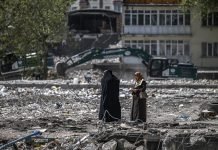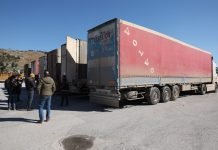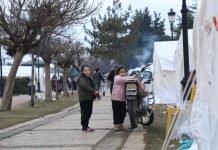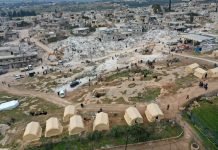
The old priest painted a warning on the cracked walls of his shack: “Twelve children were born here! Don’t touch this house.”
Vahit Baklacı, 82, returns every day to the house where he was born in the heart of old Antakya, which has been turned upside down since twin earthquakes on February 6 devastated southern Turkey and Syria, killing at least 55,000 people.
But ancient Antioch, a stone’s throw from Syria, is not just any old town, insisted the old priest.
“Antakya has existed for thousands of years. Look — two mosques dating back to the beginnings of Islam, both destroyed. And there, two 2,000-year-old churches from the time of Jesus … also destroyed. That’s why we have to be careful with these places.”
Before the disaster, the Turkish Ministry of Culture had listed 719 buildings of historic importance. When the diggers went into action, first to find the bodies and then to clear away the rubble, it posted notices to protect those still standing: “Do not touch without authorization.”
A representative of the ministry, standing in the dust in a fluorescent waistcoat and hard hat, makes sure those notices are obeyed: “If [a building] is too damaged, we can’t do anything. But when we can, we take it down stone by stone,” she said on condition of anonymity.
The stones that are saved are sorted, classified and numbered for future restoration.
Six teams like hers patrol the old town. “We had about 50 at the beginning,” she said.
‘A work of art’
Talking about the future in this city in ruins, where you walk over collapsed roofs, step over bell towers and around toppled minarets, is a leap of faith.
Architect Gökhan Ergin picked up one of the orange roof tiles strewn across the ground. It was made in Marseille in southern France which from the Ottomans and later the French imported tiles in huge quantities. Antioch was part of the French mandate of Syria before being handed to Turkey just before World War II.
“We’re standing in the city’s first residential areas. These beautiful houses were charming hotels and restaurants,” said Ergin, who has restored many of them and knows all about their mysteries, from the doors painted blue to deter scorpions to the curry plants sculpted above the entrance arches.
“It’s like when you find a work of art, you make an inventory of it to protect it in a museum. We have to do the same thing here: these buildings are just as important. It’s not just earth and stone,” said the 40-year-old. “This is living history.”
Ergin said the older buildings withstood the successive tremors of February much better because the planks and wood inserted between the mud brick structures helped absorb the shock.
Those houses that have been damaged were because of the collapse of their neighbors, who have been poorly restored, he insists. His, he proudly pointed out, still have their windows and glazing almost intact.
‘Plastic restoration’
On Kurtuluş Avenue, Antakya’s main thoroughfare, formerly Herod Street and home to the synagogue and the region’s oldest mosque, Habib-i Nejjar, built on the site of an ancient pagan temple transformed into a church in early Christian times, a team from Istanbul Technical University is carrying out its own surveys.
For Umut Almaç, professor of architecture in the restoration department, at least 800 more buildings in the city deserve protection. “That’s the problem of the region, there are so many buildings that should be registered,” he said.
In front of a former luxury hotel, with its crumbling breezeblock walls, he complained about the “plastic restorations” carried out 10 or 20 years ago to attract tourists. “They concentrated on the facade, without respecting the internal structures of the building.”
When the quake hit on February 6, tens of thousands of buildings in southern Turkey collapsed in a matter of seconds.
Almaç wants the reconstruction to be quicker, while others, including Ergin and the elderly priest Vahit, denounce the brutality of using diggers in the old town.
“But I don’t think we can move the stone blocks any other way,” said the academic.
© Agence France-Presse














